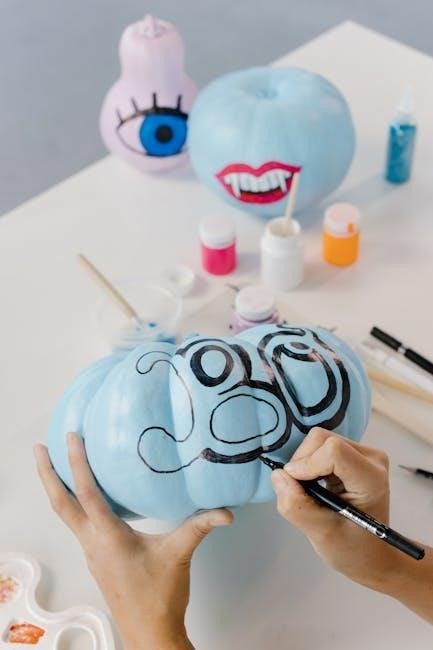Face painting is a vibrant form of artistic expression, transforming faces into living canvases for festivals, parties, and theatrical performances. Discover how to create stunning designs step by step.
What is Face Painting?
Face painting is an artistic technique where specialized paints are applied to the skin to create temporary, vibrant designs. It transforms faces into living canvases, offering a creative form of self-expression. Popular at festivals, parties, and theatrical events, face painting allows individuals to embrace their imagination through bold colors and intricate patterns. Suitable for all ages, it serves as a universal way to celebrate occasions, convey themes, or simply add artistic flair to any gathering.
Popular Uses of Face Painting
Face painting is widely used in various settings to enhance creativity and entertainment. It is a staple at festivals, carnivals, and children’s parties, where vibrant designs like superheroes or princesses captivate audiences. Additionally, it is employed in theatrical performances, sports events, and cultural celebrations to convey themes or team spirit. For adults, it can be a form of artistic expression or a unique addition to themed events. Its versatility makes it a popular choice for bringing joy and creativity to people of all ages.
Why Learn Face Painting?
Learning face painting unlocks a world of creativity and self-expression, allowing you to transform faces into stunning works of art. It’s a skill that can be used to entertain at parties, create memorable experiences for children, or even as a professional service. Face painting fosters artistic growth, enhances fine motor skills, and builds confidence. Whether for personal enjoyment or career opportunities, mastering face painting opens doors to endless possibilities in art, entertainment, and community engagement.

Materials and Supplies Needed
Essential materials include high-quality face paint, brushes, sponges, water, and a palette. Additional supplies like wipes and hygiene products ensure a safe and enjoyable experience.
Essential Face Painting Kits
A good face painting kit is the cornerstone of your craft, offering everything you need to get started. These kits typically include high-quality, non-toxic face paints in a variety of vibrant colors, along with essential tools like soft brushes, sponges, and applicators. Many kits also come with stencils or design guides to help you create intricate patterns. Additionally, look for kits that include hygiene items like wipes and a small water spray bottle to keep your tools clean and your designs fresh. These kits are perfect for both beginners and professionals, providing the versatility to craft simple or elaborate designs with ease.
Types of Face Paint
Face paints come in various forms, with water-based and alcohol-based being the most common. Water-based paints are gentle on skin and easy to remove, making them ideal for children and sensitive skin. Alcohol-based paints are more durable and vibrant but can be harsh. Hybrid paints offer a balance, combining the benefits of both. All types are typically non-toxic and FDA-compliant, ensuring safety for use on the skin. Choosing the right type depends on the design’s complexity, skin sensitivity, and desired finish.
Brushes and Sponges
High-quality brushes and sponges are essential tools for face painting. Brushes come in various sizes, with flat brushes ideal for base colors and round brushes perfect for detailed outlines. Sponges are great for blending and creating soft textures. Natural and synthetic sponges offer different effects, while angled brushes help reach small areas. Proper hygiene is crucial—sanitize tools regularly to prevent infections. Investing in durable, versatile brushes and sponges ensures professional results and longevity of your face painting designs.
Preparation and Hygiene
Preparation and hygiene are key for safe face painting. Sanitize tools and clean the skin before painting for a smooth, safe experience.
Sanitizing Your Tools
Sanitizing your face painting tools is essential for maintaining hygiene. Use isopropyl alcohol to wipe brushes and sponges between applications. For deep cleaning, soak brushes in warm soapy water. Regularly sanitize your tools to prevent the spread of germs and ensure a safe experience for everyone. Always allow tools to air dry before reuse to maintain their quality and prevent bacterial growth.
Preparing the Skin
Before face painting, ensure the skin is clean, dry, and free of oils or makeup. This helps the paint adhere better and last longer. Gently wash the area with mild soap and pat it dry. Avoid applying lotions or moisturizers, as they can create a barrier. If the skin is sensitive, perform a patch test with a small amount of paint. Proper preparation ensures a smooth, even application and prevents potential allergic reactions.

Basic Face Painting Techniques
Mastering essential techniques like base application, detail work, and blending is crucial. Start with smooth strokes for base colors, then add details with fine brushes, and blend for depth.
Applying Base Colors
Applying base colors is the foundation of face painting. Start by preparing the skin with a mild cleanser and moisturizer. Use a large sponge or brush to cover the area evenly. Choose vibrant, skin-safe paints and thin them slightly for smoother application. Work in light layers, allowing each to dry before adding more color. This ensures a seamless finish and prevents cakeiness. Select base colors that complement the design, such as solid tones for backgrounds or bold hues for focal points. Blend edges gently for a natural look.
Creating Details and Outlines
Creating details and outlines enhances the definition and depth of your face painting design. Use thin, fine brushes to paint intricate lines, borders, and patterns. Start by outlining the design to guide your strokes, then fill in details like eyes, textures, or small features. Opt for contrasting colors to make details stand out. Practice steady, controlled movements to achieve sharp, clean lines. This step adds personality and dimension, transforming your base colors into a polished masterpiece.
Blending and Layering
Blending and layering are essential techniques for creating smooth transitions and depth in face painting. Start by applying light base colors, gradually building up layers for vibrancy. Use sponges or damp brushes to blend edges seamlessly, ensuring no harsh lines remain. Allow each layer to dry slightly before adding more details. This method prevents colors from muddying and enhances the overall design’s clarity and dimension. Practice blending to achieve soft, natural-looking transitions that bring your artwork to life.

Popular Face Painting Designs
Popular face painting designs include animals, superheroes, floral patterns, and festive themes like Halloween masks or Christmas motifs. These designs are crowd-pleasers for all ages and occasions.
Simple Designs for Beginners
Simple face painting designs, like stripes, dots, or small animals, are perfect for beginners. They require minimal supplies and basic techniques, making them easy to master. Start with one-color designs, then gradually add details. Practice on friends or family to build confidence. These designs are quick, fun, and great for events like birthday parties or festivals. With practice, you’ll soon move on to more complex creations, but these basics will form a solid foundation for your face painting journey.
Advanced Designs for Special Occasions
Advanced face painting designs are perfect for special occasions like Halloween, festivals, or theatrical performances. These intricate designs often feature multi-color layering, detailed patterns, and 3D effects. Techniques like blending, shading, and stenciling create realistic looks, such as superheroes, mythical creatures, or elaborate masks. Practice these designs to master precision and creativity, transforming faces into stunning works of art for memorable events and celebrations.

Tips and Tricks
Master face painting techniques by sanitizing tools, using high-quality paints, and practicing regularly. Choose the right brushes, blend colors smoothly, and use reference images for inspiration. Patience and precision are key to creating stunning, long-lasting designs.
Common Mistakes to Avoid
When face painting, avoid using thick layers of paint, as this can cause cracking and discomfort. Ensure tools are properly sanitized to prevent infections. Avoid using low-quality paints, as they may irritate the skin or fade quickly. Don’t skip preparing the skin, as this ensures better adhesion and longevity. Avoid copying complex designs without practice, as this can lead to disappointment. Lastly, never rush—take your time to blend colors smoothly and create crisp outlines for professional-looking results.
How to Make Designs Last Longer
To ensure face paint designs last longer, use high-quality, water-resistant paints and thin layers. Apply a primer or base coat first for better adhesion. Avoid touching or rubbing the painted area, as oils from the skin can smudge the design. Set the paint with a setting spray to enhance durability. Keep the skin moisturized beforehand to prevent cracking. Avoid using heavy makeup or creams near the design. For outdoor events, use sweat-resistant products to maintain vibrant colors throughout the day.
Face painting is a creative art form that brings joy and self-expression. With practice, you’ll master techniques, inspire confidence, and transform faces into vibrant masterpieces. Keep exploring and enjoying the process!
Encouragement to Practice
Practice is the key to mastering face painting. Start with simple designs and gradually experiment with more complex techniques. Don’t be afraid to make mistakes—they are part of the learning process. Use online guides and tutorials to refine your skills. Keep experimenting with colors and styles to develop your unique artistic voice. Remember, consistency and patience will help you improve. With dedication, you’ll create stunning designs that bring joy to others. Happy painting!
Final Thoughts on Face Painting
Face painting is a transformative art form that brings joy and creativity to people of all ages. With practice, patience, and creativity, you can master various techniques and designs. Remember, it’s not just about painting—it’s about creating memorable experiences. Keep experimenting, learning, and sharing your art with others. Face painting has the power to inspire and connect people, making it a truly rewarding hobby or profession. Embrace the process, stay creative, and enjoy the journey of bringing beauty to others’ lives!





